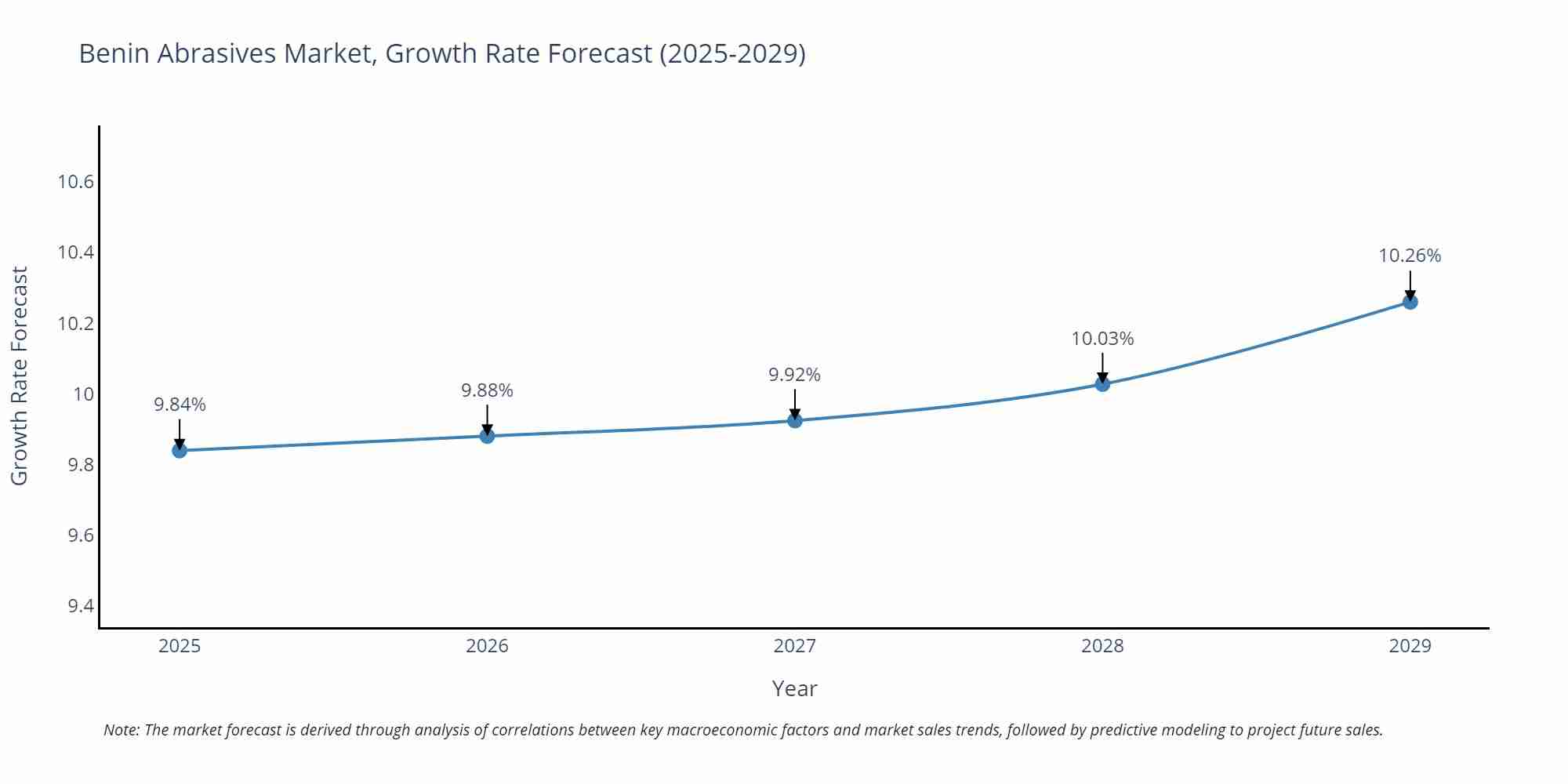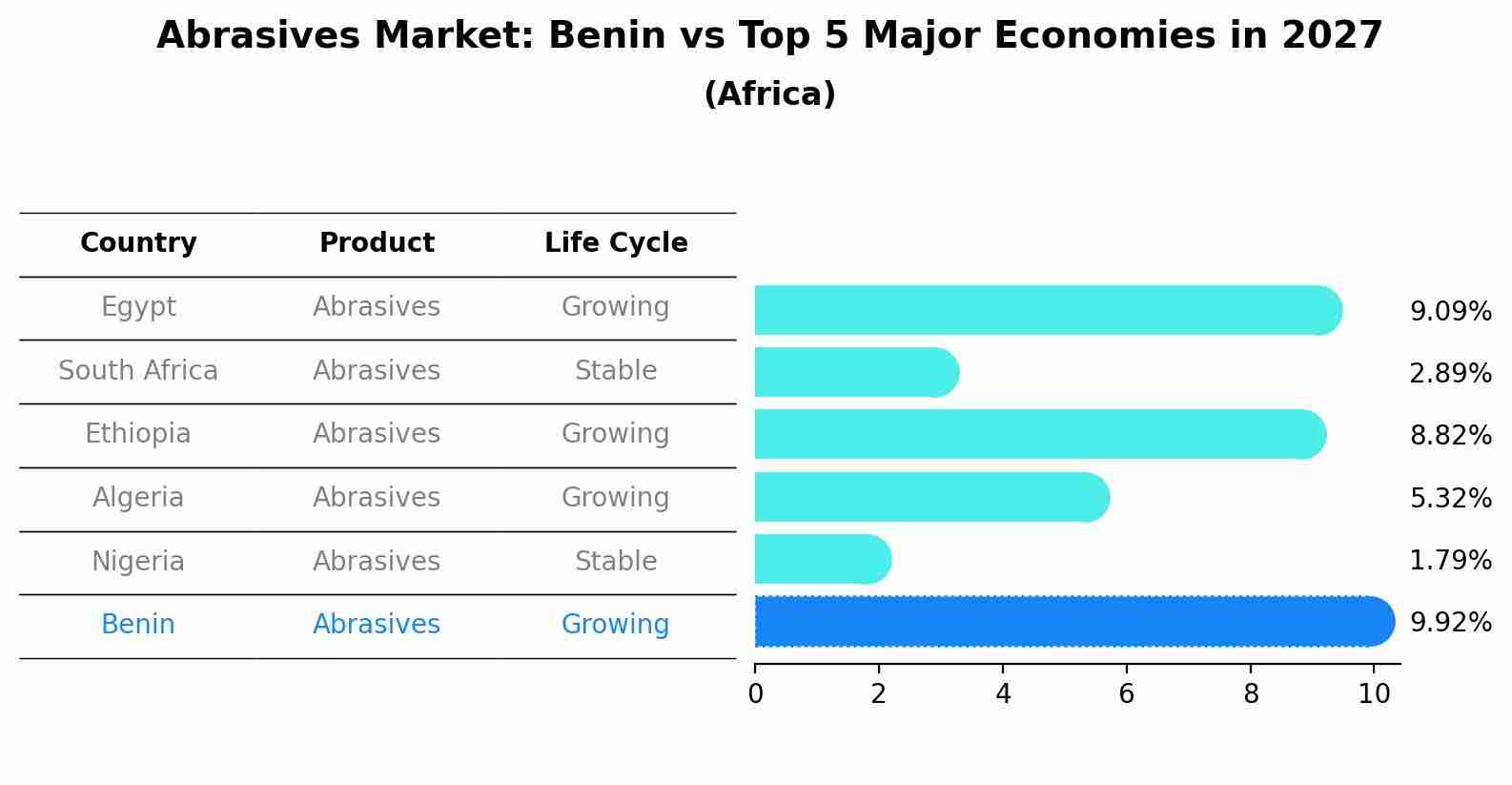Benin Abrasives Market (2025-2031) | Trends, Size, Forecast, Analysis, Revenue, Companies, Value, Outlook, Segmentation, Share, Industry & Growth
| Product Code: ETC4855569 | Publication Date: Nov 2023 | Updated Date: Sep 2025 | Product Type: Market Research Report | |
| Publisher: 6Wresearch | Author: Shubham Padhi | No. of Pages: 60 | No. of Figures: 30 | No. of Tables: 5 |
Benin Abrasives Market Size Growth Rate
The Benin Abrasives Market is poised for steady growth rate improvements from 2025 to 2029. From 9.84% in 2025, the growth rate steadily ascends to 10.26% in 2029.

Abrasives Market: Benin vs Top 5 Major Economies in 2027 (Africa)
In the Africa region, the Abrasives market in Benin is projected to expand at a growing growth rate of 9.92% by 2027. The largest economy is Egypt, followed by South Africa, Ethiopia, Algeria and Nigeria.

Key Highlights of the Report:
- Benin Abrasives Market Outlook
- Market Size of Benin Abrasives Market, 2024
- Forecast of Benin Abrasives Market, 2031
- Historical Data and Forecast of Benin Abrasives Revenues & Volume for the Period 2021-2031
- Benin Abrasives Market Trend Evolution
- Benin Abrasives Market Drivers and Challenges
- Benin Abrasives Price Trends
- Benin Abrasives Porter`s Five Forces
- Benin Abrasives Industry Life Cycle
- Historical Data and Forecast of Benin Abrasives Market Revenues & Volume By Product for the Period 2021-2031
- Historical Data and Forecast of Benin Abrasives Market Revenues & Volume By Coated for the Period 2021-2031
- Historical Data and Forecast of Benin Abrasives Market Revenues & Volume By Bonded for the Period 2021-2031
- Historical Data and Forecast of Benin Abrasives Market Revenues & Volume By Others for the Period 2021-2031
- Historical Data and Forecast of Benin Abrasives Market Revenues & Volume By Application for the Period 2021-2031
- Historical Data and Forecast of Benin Abrasives Market Revenues & Volume By Automotive & Transportation for the Period 2021-2031
- Historical Data and Forecast of Benin Abrasives Market Revenues & Volume By Heavy Machinery for the Period 2021-2031
- Historical Data and Forecast of Benin Abrasives Market Revenues & Volume By Metal Fabrication for the Period 2021-2031
- Historical Data and Forecast of Benin Abrasives Market Revenues & Volume By Electrical & Electronics Equipment for the Period 2021-2031
- Historical Data and Forecast of Benin Abrasives Market Revenues & Volume By Others for the Period 2021-2031
- Benin Abrasives Import Export Trade Statistics
- Market Opportunity Assessment By Product
- Market Opportunity Assessment By Application
- Benin Abrasives Top Companies Market Share
- Benin Abrasives Competitive Benchmarking By Technical and Operational Parameters
- Benin Abrasives Company Profiles
- Benin Abrasives Key Strategic Recommendations
Frequently Asked Questions About the Market Study (FAQs):
1 Executive Summary |
2 Introduction |
2.1 Key Highlights of the Report |
2.2 Report Description |
2.3 Market Scope & Segmentation |
2.4 Research Methodology |
2.5 Assumptions |
3 Benin Abrasives Market Overview |
3.1 Benin Country Macro Economic Indicators |
3.2 Benin Abrasives Market Revenues & Volume, 2021 & 2031F |
3.3 Benin Abrasives Market - Industry Life Cycle |
3.4 Benin Abrasives Market - Porter's Five Forces |
3.5 Benin Abrasives Market Revenues & Volume Share, By Product, 2021 & 2031F |
3.6 Benin Abrasives Market Revenues & Volume Share, By Application, 2021 & 2031F |
4 Benin Abrasives Market Dynamics |
4.1 Impact Analysis |
4.2 Market Drivers |
4.2.1 Growing industrial manufacturing sector in Benin leading to increased demand for abrasives. |
4.2.2 Rising construction activities and infrastructure development projects in Benin requiring abrasives for various applications. |
4.2.3 Increasing adoption of advanced abrasive technologies and materials for enhanced productivity and quality in manufacturing processes. |
4.3 Market Restraints |
4.3.1 Fluctuating raw material prices impacting the overall production cost of abrasives. |
4.3.2 Lack of skilled labor and technical expertise in handling advanced abrasive tools and equipment. |
4.3.3 Stringent regulations and compliance standards related to environmental impact and occupational safety affecting the market growth of abrasives in Benin. |
5 Benin Abrasives Market Trends |
6 Benin Abrasives Market Segmentations |
6.1 Benin Abrasives Market, By Product |
6.1.1 Overview and Analysis |
6.1.2 Benin Abrasives Market Revenues & Volume, By Coated, 2021-2031F |
6.1.3 Benin Abrasives Market Revenues & Volume, By Bonded, 2021-2031F |
6.1.4 Benin Abrasives Market Revenues & Volume, By Others, 2021-2031F |
6.2 Benin Abrasives Market, By Application |
6.2.1 Overview and Analysis |
6.2.2 Benin Abrasives Market Revenues & Volume, By Automotive & Transportation, 2021-2031F |
6.2.3 Benin Abrasives Market Revenues & Volume, By Heavy Machinery, 2021-2031F |
6.2.4 Benin Abrasives Market Revenues & Volume, By Metal Fabrication, 2021-2031F |
6.2.5 Benin Abrasives Market Revenues & Volume, By Electrical & Electronics Equipment, 2021-2031F |
6.2.6 Benin Abrasives Market Revenues & Volume, By Others, 2021-2031F |
7 Benin Abrasives Market Import-Export Trade Statistics |
7.1 Benin Abrasives Market Export to Major Countries |
7.2 Benin Abrasives Market Imports from Major Countries |
8 Benin Abrasives Market Key Performance Indicators |
8.1 Average utilization rate of advanced abrasive technologies in manufacturing industries. |
8.2 Number of new infrastructure projects using abrasives in construction sector. |
8.3 Rate of adoption of environmentally friendly abrasive materials and technologies. |
8.4 Level of investment in research and development for innovative abrasive products. |
8.5 Ratio of skilled labor trained in advanced abrasive tools and techniques. |
9 Benin Abrasives Market - Opportunity Assessment |
9.1 Benin Abrasives Market Opportunity Assessment, By Product, 2021 & 2031F |
9.2 Benin Abrasives Market Opportunity Assessment, By Application, 2021 & 2031F |
10 Benin Abrasives Market - Competitive Landscape |
10.1 Benin Abrasives Market Revenue Share, By Companies, 2024 |
10.2 Benin Abrasives Market Competitive Benchmarking, By Operating and Technical Parameters |
11 Company Profiles |
12 Recommendations | 13 Disclaimer |
- Single User License$ 1,995
- Department License$ 2,400
- Site License$ 3,120
- Global License$ 3,795
Search
Thought Leadership and Analyst Meet
Our Clients
Related Reports
- Germany Breakfast Food Market (2026-2032) | Industry, Share, Growth, Size, Companies, Value, Analysis, Revenue, Trends, Forecast & Outlook
- Australia Briquette Market (2025-2031) | Growth, Size, Revenue, Forecast, Analysis, Trends, Value, Share, Industry & Companies
- Vietnam System Integrator Market (2025-2031) | Size, Companies, Analysis, Industry, Value, Forecast, Growth, Trends, Revenue & Share
- ASEAN and Thailand Brain Health Supplements Market (2025-2031) | Strategy, Consumer Insights, Analysis, Investment Trends, Opportunities, Growth, Size, Share, Industry, Revenue, Segments, Value, Segmentation, Supply, Forecast, Restraints, Outlook, Competition, Drivers, Trends, Demand, Pricing Analysis, Competitive, Strategic Insights, Companies, Challenges
- ASEAN Bearings Market (2025-2031) | Strategy, Consumer Insights, Analysis, Investment Trends, Opportunities, Growth, Size, Share, Industry, Revenue, Segments, Value, Segmentation, Supply, Forecast, Restraints, Outlook, Competition, Drivers, Trends, Demand, Pricing Analysis, Competitive, Strategic Insights, Companies, Challenges
- Europe Flooring Market (2025-2031) | Outlook, Share, Industry, Trends, Forecast, Companies, Revenue, Size, Analysis, Growth & Value
- Saudi Arabia Manlift Market (2025-2031) | Outlook, Size, Growth, Trends, Companies, Industry, Revenue, Value, Share, Forecast & Analysis
- Uganda Excavator, Crane, and Wheel Loaders Market (2025-2031) | Strategy, Consumer Insights, Analysis, Investment Trends, Opportunities, Growth, Size, Share, Industry, Revenue, Segments, Value, Segmentation, Supply, Forecast, Restraints, Outlook, Competition, Drivers, Trends, Demand, Pricing Analysis, Competitive, Strategic Insights, Companies, Challenges
- Rwanda Excavator, Crane, and Wheel Loaders Market (2025-2031) | Strategy, Consumer Insights, Analysis, Investment Trends, Opportunities, Growth, Size, Share, Industry, Revenue, Segments, Value, Segmentation, Supply, Forecast, Restraints, Outlook, Competition, Drivers, Trends, Demand, Pricing Analysis, Competitive, Strategic Insights, Companies, Challenges
- Kenya Excavator, Crane, and Wheel Loaders Market (2025-2031) | Strategy, Consumer Insights, Analysis, Investment Trends, Opportunities, Growth, Size, Share, Industry, Revenue, Segments, Value, Segmentation, Supply, Forecast, Restraints, Outlook, Competition, Drivers, Trends, Demand, Pricing Analysis, Competitive, Strategic Insights, Companies, Challenges
Industry Events and Analyst Meet
Whitepaper
- Middle East & Africa Commercial Security Market Click here to view more.
- Middle East & Africa Fire Safety Systems & Equipment Market Click here to view more.
- GCC Drone Market Click here to view more.
- Middle East Lighting Fixture Market Click here to view more.
- GCC Physical & Perimeter Security Market Click here to view more.
6WResearch In News
- Doha a strategic location for EV manufacturing hub: IPA Qatar
- Demand for luxury TVs surging in the GCC, says Samsung
- Empowering Growth: The Thriving Journey of Bangladesh’s Cable Industry
- Demand for luxury TVs surging in the GCC, says Samsung
- Video call with a traditional healer? Once unthinkable, it’s now common in South Africa
- Intelligent Buildings To Smooth GCC’s Path To Net Zero


















